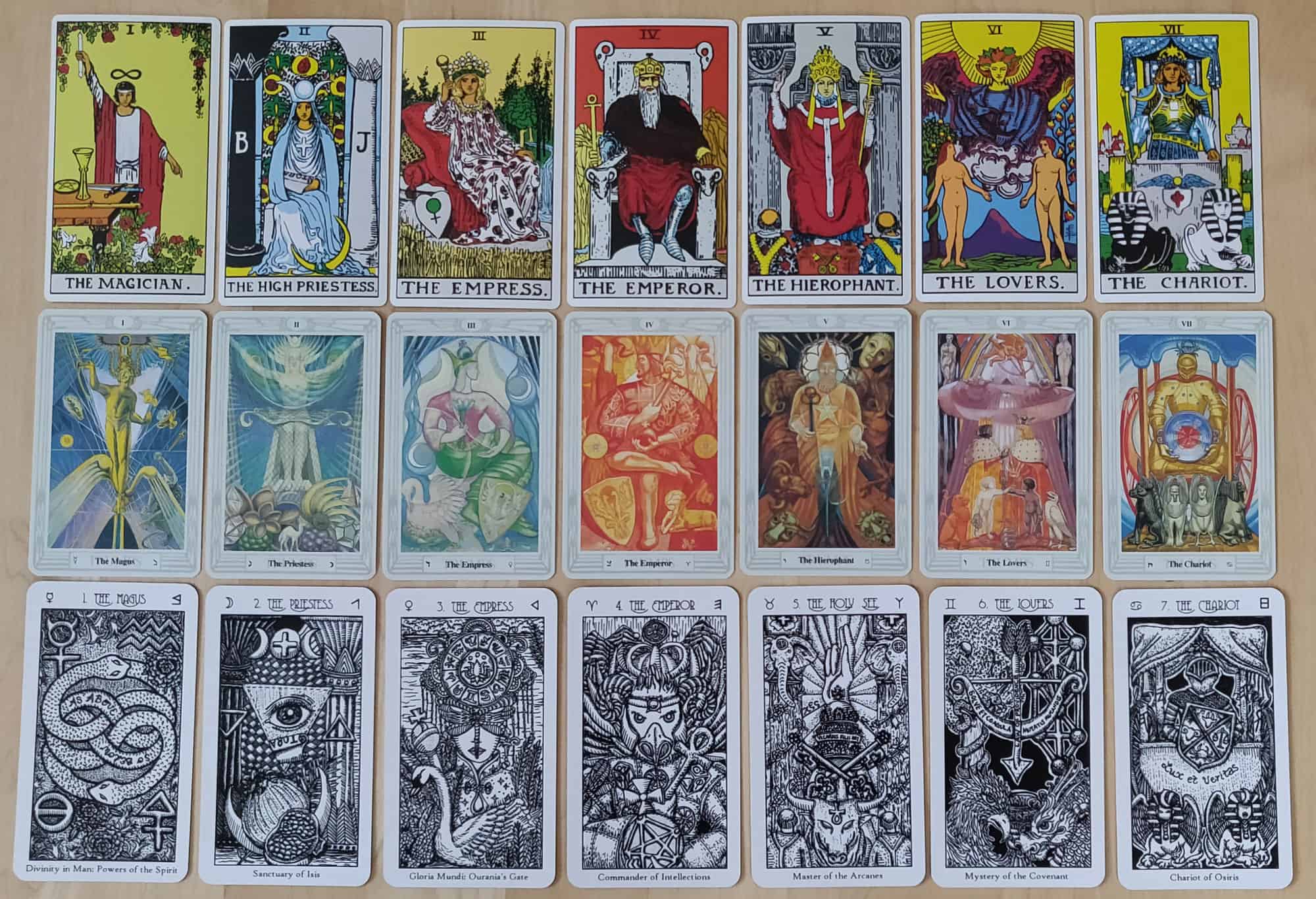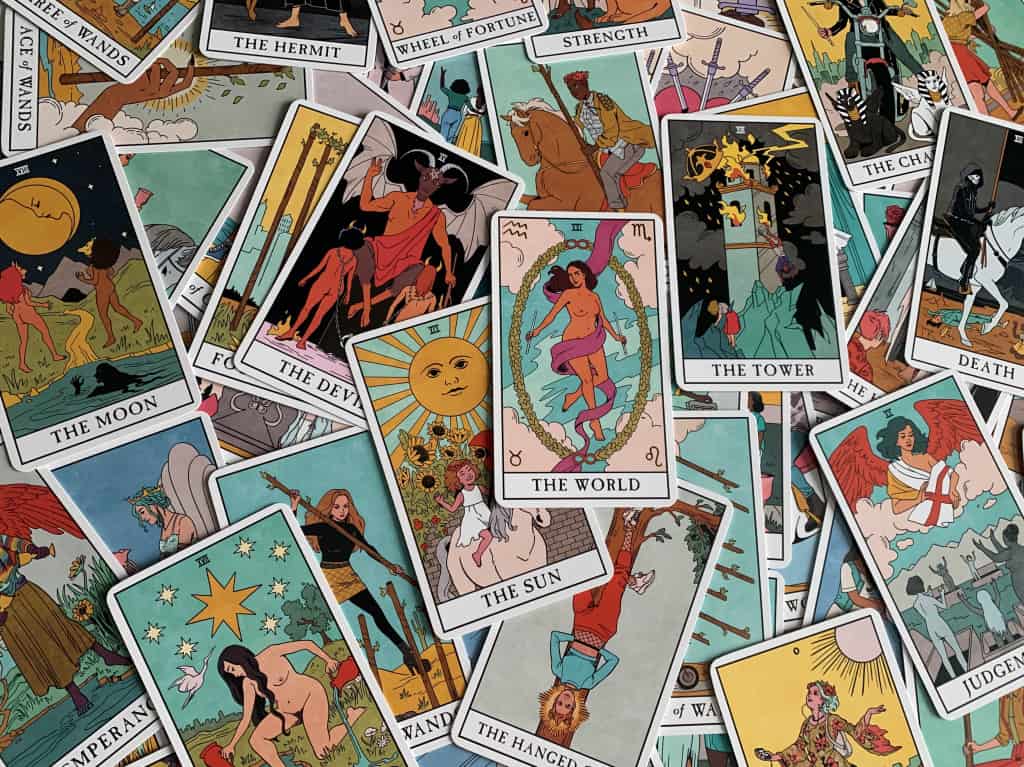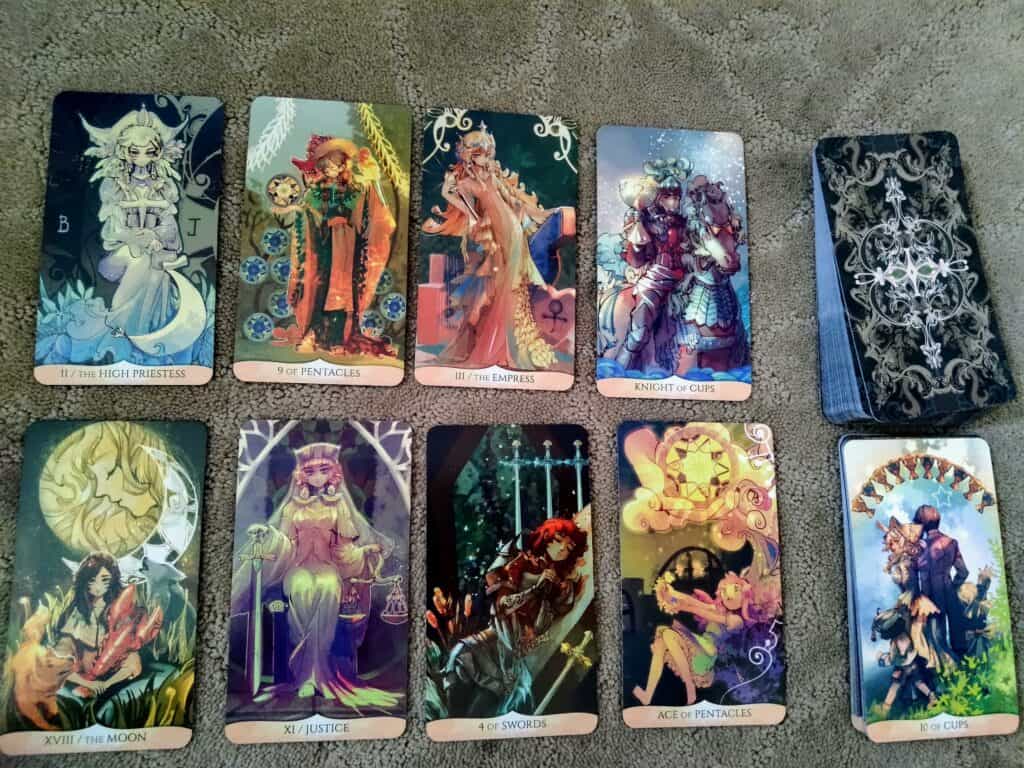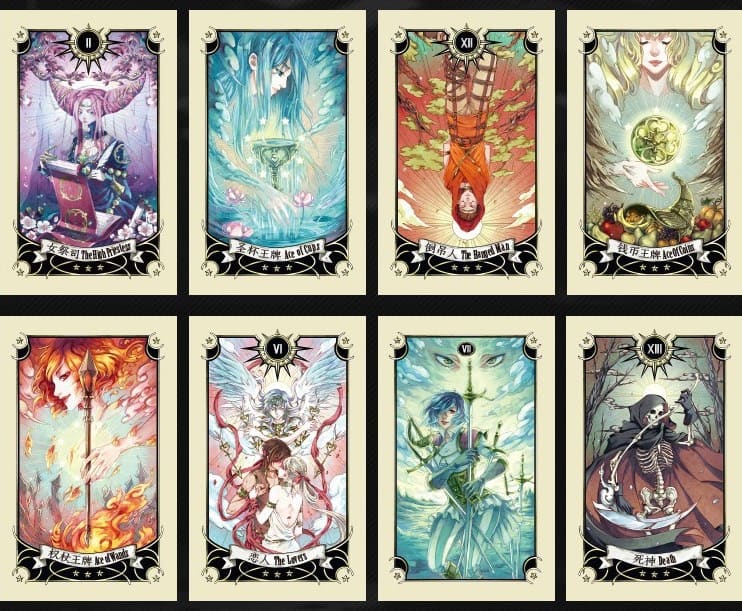- Celtic Cross Spread Explained: What Does it Mean? - October 9, 2021
- What is the Best Tarot Deck and Which is Right for You? - June 25, 2021
A Brief History
In the 1780s, tarot cards made their shift from Italian to French culture. While they had been used strictly as a card game in one country, they began their shift into the world of the occult.
Jean Baptiste Alliette was the first to use the cards for divination purposes in 1783. He allowed that the major arcana (made up of 22 cards) were related to spiritual meanings.
The minor arcana, composed of 56 cards, were split according to the suit that each card bore. Cups (or chalices) were deemed to represent love and strong emotions. Swords represent a person’s problems or troubles. Wands (sometimes referred to as sticks) demonstrated business, work, or general social matters. Lastly, pentacles have ascribed the trait of finances. Each card, both in the major and minor arcana, can have two meanings: one meaning represents the card in an upward position, another for when the card is placed upside down (or reversed).
At this time, the cards were printed from woodcuts and colored in by hand using stencils. The most commonly used deck in France was called the Tarot of Marseilles; this name was coined in 1856 by a man named Romain Merlin.
Then, just over fifty years later, A Englishman named Arthur Edward Waite published Alliette’s work translated into English. Fascinated by Alliette’s work on the tarot, he was inspired to create his own deck.
Between the years of 1938 and 1942, Alister Crowley released The Thoth deck with the help of Frieda Harris who released a series of paintings illustrating the images within the cards.
In 1920, Paul Foster Case, an American occultist, published a book called An Introduction to the Study of the Tarot and used Waite’s deck as the standard deck to read by. Ten years later, Case prompted the Revised New Art Tarot.
The first deck containing photographed images was released in 1975 and was called the Mountain Dream Tarot.
Throughout the 1980s and 1990s, the use of the tarot became a more introspective and private journey. While people still read cards in shops and at parties for a fee, more commonly readers of the tarot were using their knowledge to gain personal insight and growth.
Currently, due to the ability to self-publish, tarot decks abound. They can be found in any style and in many different languages. Decks illustrating LGBTQ+ pride, feminism, television shows, movies, books, and more exist to be purchased on many popular shopping websites. As well, tarot cards are a staple in any occult store.
When Choosing a Deck
With countless styles of tarot decks available, it can sometimes be overwhelming for the newcomer to decide which deck is best for them.
There are two major schools of thought when it comes to the choosing of a deck. One is that the deck should choose the person, not the other way around. The reader should sit with the decks in a store (if possible) and see which one speaks to them. It may not be a particularly “pretty” or “gruesome” deck (depending on your tastes), but if it calls out to the reader, that is the one they should choose.
The other side of this says that a deck should never be purchased by the person who wishes to use it; decks should always be gifted. The reasoning behind this is that, provided the gift was done thoughtfully, it will create a strong bond between the reader and the deck because was chosen specifically with them in mind.
Finally, there are others who throw all caution to the wind and just purchase whatever deck suits their fancy: maybe it has pretty pictures, maybe it’s based on their favorite tv show, whatever! Either way, when beginning to learn how to read the cards, have fun with them.
Rider Waite-Smith

This deck is considered one of the original tarot decks. It is sometimes referred to as the Rider Waite tarot or the Waite-Smith tarot; any of these names typed into a search engine will bring up this particular tarot. Designed by Arthur Edward Waite in 1909, this deck was created in collaboration with Pamela Coleman Smith who is credited for the illustrations and published by William Rider & Son in London.
During the creation process of these illustrations, Waite and Smith worked closely together; it is said that she created each image based on Waite’s explicit direction. When creating the images for this deck, Waite and Smith included symbolism, going as far as choosing specific colors that are synonymous with different emotions. Waite wanted to step away from the more traditional Christian-style cards for what was then considered modern. He was fascinated by the Hermetic Order of the Golden Dawn as well as the occultist Eliphas Levi; many references to the teachings of the Golden Dawn as well as Levi can be found within the deck.
The minor arcana of this deck combines color theory with allegory to create images that are easily recognizable and, upon closer study, open the reader up to the deeper meanings of the cards. A self-directed study of this deck (or any deck) is always encouraged before offering readings; connecting with the deck is key.
The major arcana, on the other hand, experienced some changes from its 1500s predecessor. Waite, to keep with the astrological teachings of the Golden Dawn, switched the cards Strength and Justice. This allowed Strength to be associated with the zodiac sign of Leo and Justice with Libra. He also added a second person to The Lovers so that the card mirrored Gemini, the twins.
To date, they’ve sold an estimated 100 million copies worldwide. Due to its vast popularity, this deck is often portrayed in films and television and has even spawned a more modernized version.
Modern Witch Tarot

Based on the ever-popular Rider Waite-Smith deck, the Modern Witch Tarot gives a 21st-century spin on a classic. Unlike its predecessor, this deck features an all-female ensemble celebrating diversity and womanhood. Lisa Sterle is an accomplished artist and has worked on many different projects, often combining her interest in the grotesque and the beautiful.
The Modern Witch Tarot was published in 2019 by Sterling Publishing & Liminal 11. Then, the following year, she published an accompanying book, Modern Witch Tarot Journal. This book provides space to record meanings of the cards, different readings conducted, different tarot spreads, and more.
The face side of each card follows a vibrant color scheme, similar to the RWS deck. Each card depicts women of different sizes and colors celebrating herself and her womanhood. The backside of each card is a soft turquoise with the initials MW (for Modern Witch) and features key images from the deck such as swords, wands, chalices, and pentacles. As well there is a large eye in the center and two keys on either side of the chalice. Symbolism abounds in this deck both within the face cards and on the cover art.
Upon purchasing this deck, the reader is given a beautiful hard covered book containing the tarot meanings of each card, and the story behind Lisa’s adaptation of the Rider Waite-Smith deck. It’s a beautiful addition to a modern, empowering deck.
Manga Tarot

Next on our list is the Manga Tarot. This deck features bright colors and beautiful imagery based on Japanese-style manga. This art style originated in Japan in the 19th century. The word “manga” refers to all kinds of animation and cartooning done in this specific style. These characters usually have soft features, big, bright eyes, and vivid colors.
There are many different versions of this deck, but the one referenced in this article was published by Llewellyn. For those who are unfamiliar, Llewellyn is a leading publisher in all things occults from books to tarot decks, calendars to magical items. Lo Scarabeo is credited as the creator of the deck, though little information can be found otherwise.
On the rear of each card is a beautiful depiction of a Japanese warrior in a meditative state; this image is a mirror both on the top and the bottom and features the classic ying-yang symbol separating the two. Hues of maroon and brown serve as the backdrop to each back allowing the viewer’s gaze to settle on the sedated warrior. It almost seems, with placement and consideration, that the warrior is asking the querent to focus and meditate on what their question is, prior to their reading.
Pop Culture decks
For this section, it’s too difficult to highlight one specific deck as there are hundreds. Pop culture refers to anything in media that is currently in fashion or popular. This can include books, television shows, movies, video games, and so many more!
Popular culture decks follow the same format as a regular deck, it’s just that the face cards are styled after something specific.
Some examples of pop culture decks are Game of Thrones, Supernatural, Friends, Disney Villains, Nightmare Before Christmas, Alice in Wonderland, and there is even a tarot deck dedicated to the works of Jane Austen. These decks can appeal to anyone and are no less valuable than the original RWS deck as they’re all based on the same principle.
What are the pros?
One common advantage of the decks listed above is their availability. Due to increasing popularity over the last number of years, the production of tarot decks has taken off. Now too with the ability to self publish, releasing more and more niche decks has never been easier.
The RWS deck as well as the Modern Witch tarot are available at many major book stores and are both easily available online. With things like “same day” shipping, having a tarot deck delivered to your mailbox or doorstep takes no time at all.
It’s important to note too that many occult shops will carry an assortment of tarot decks as well. These may be more stereotypically occult looking (dark, featuring cats, crows, etc) but are incredibly beautiful as well.
What are the cons?
One of the disadvantages to purchasing tarot cards, regardless of what kind or style, is the price. There are many factors that play into the price of a deck as well as where in the world you plan to do your shopping. Larger, chain stores tend to up their prices because they need to take a percentage, similarly, occult stores do the same.
Though, it is often less of a markup than the larger stores. If a deck really speaks to you but the price is steep, save up and purchase it when you can. Owners of these occult shops (or chain retailers) will often order in decks on the request of shoppers. Never be afraid to approach anyone in an occult shop specifically- they’re there to help!
Speaking specifically now of the pop culture decks, they can have a bit of a bad reputation for being “cute”. Though it shouldn’t matter, there are some readers and seekers alike who will look down on pop culture decks as being silly or childish. It’s important to remember that, no matter what anyone says, if you the reader are comfortable with your deck then no one should deter you from using it.
Frequently Asked Questions
Question: Can I choose my own deck?
Answer: There is a lot of debate about this particular question. As someone who has been gifted decks and purchased her own, I don’t believe any singular deck is better than the other. I think there are merits to having someone you love and trust gift you a deck (whether it was one you picked out or one they thought you’d like).
However, if you are perhaps someone who isn’t comfortable asking for this kind of gift and wants to purchase a deck yourself, there are things you can do to help bond yourself to your deck. Sleeping with it under your pillow, for example, or beside your bed. You can consecrate it using a simple consecration incantation. Or you can create a little cloth bag and carry your cards with you during your day. All these actions will help you become comfortable with your deck.
Question: Where can you buy tarot decks?
Answer: As mentioned earlier in the article, there are countless places to purchase tarot decks. Websites like Etsy offer more handcrafted decks which can be more unique or specialized. Amazon offers many different styles of decks as well. Large chain bookstores often have a “New Age” or “Occult” section where decks can be purchased along with books on how to read the tarot.
There is a nearly endless library of books on how to read the cards and on different spreads that exist. Lastly, it’s important to mention occult shops. These shops are run by people who are genuinely interested in all manner of things occult and who often know a lot more about reading them than a simple internet search would do. They are a wealth of knowledge and should be used appropriately.
Question: Are oracle cards the same as tarot cards?
Answer: No. While they have some similar properties, oracle cards are different. These cards come in smaller decks and usually only have one meaning (reversed meanings don’t apply to them).
They can have a word or phrase printed on them to help guide the seeker to their answer. While it’s common to use these cards in a complete spread, oracle cards can be used one at a time and don’t need to relate to each other the way tarot cards would. When searching for a tarot deck, it’s important to be sure the deck you’ve selected isn’t actually an oracle deck; your readings won’t be nearly the same.
What I Recommend

As someone who has been reading tarot cards for seventeen years, I’ve owned a fair amount of decks. My very first one was the Manga Tarot which was gifted to me when I was thirteen years old and it meant the world to me. I use this deck the most often as the woman who gave it to me is no longer living; I feel closest to her when I’m reading using this deck. It’s worn around the edges and I’m incredibly careful with it, but it is by far my favorite.
That being said though when I perform readings for friends or groups, I use the Rider Waite Smith deck. It’s classic, sleek, and straightforward. In a lot of readings, people tend not to get as absorbed in the visuals of the deck because they are, arguably, a bit bland. This allows the seeker to focus on what I’m reading in the cards. It is also a great introductory deck for anyone who is new to reading. Inside the box is a little booklet with impossibly small print that outlines different spreads and the various meanings to each card within the deck.
For a Beginner
For someone just starting out, I would recommend the Rider Waite Smith deck. It is the most common one for beginners and tends to be the most “iconic”. The book that accompanies the deck contains a brief, but detailed history of the deck, and contains explanations of each card within the deck.
That being said, however, depending on whether or not the reader wants to choose their own deck, they may simply wish to pick a deck that speaks to them. There is more on this in the FAQ section below.
For a Seasoned Reader
For someone who has been reading the cards for a while, they will have come up with what works best for them. They will probably have a deck or two that they trust to use the most often. When choosing to expand their tarot library though, they may ask other readers what they have been using, or check out their favorite publishers to what’s new.
In either case, whether you’re a beginner, or a well-trained reader, reading reviews on decks is also a handy way to gauge your interest in other decks too.
Continue reading:
Find more interesting decks below:
Forest of Enchantment Tarot Deck Review
Best Animal Tarot Themed Deck Ideas for Any Divination
Egyptian Tarot Deck Ideas: Decks Inspired by Ancient Mythology

